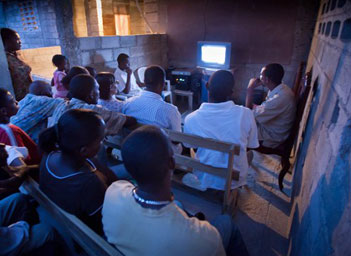 “SO, what do you do?” America’s quintessential get-to-know-you question is a lot harder to answer these days, between the realities of the new freelance economy, the ever-shifting lines between work and home life, and a revived quest for meaning that often manifests itself in unconventional ways.
“SO, what do you do?” America’s quintessential get-to-know-you question is a lot harder to answer these days, between the realities of the new freelance economy, the ever-shifting lines between work and home life, and a revived quest for meaning that often manifests itself in unconventional ways.
Barna Group’s new research shows that three-quarters of U.S. adults (75%) say they are looking for ways to live a more meaningful life. Whether such meaning is found in family, career, church, side projects or elsewhere, these are all questions of vocation—that is, the way in which people feel “called” to certain types of work and life choices. And in 2014, these questions remain as strong as ever for millions of Americans
Among Christians, there is an additional question: “What does God want me to do with my life?” According to Barna Group’s study, only 40% of practicing Christians say they have a clear sense of God’s calling on their lives. Christian Millennials are especially sensitive to this divine prompting—nearly half (48%) say they believe God is calling them to different work, yet they haven’t yet made such a change.
Sermons are commonly preached on evangelism, discipleship, and spiritual disciplines—but what about vocation? It turns out that most churchgoers are craving more direction and discipleship when it comes to the theology of calling, especially as it relates to work. Barna research shows nearly two-thirds of churched adults say it has been at least three years or more since they heard church teachings on work and career, and yet, the workplace is where most Americans spend a the biggest share of their waking hours.
However, connecting faith and work is of significant importance to the Christian community. And the following three work and faith trends for 2014 reveal opportunities for the Church to engage vocational discipleship in new ways:
1) Millions of adults are choosing a multi-career path.
A changing economy, a burgeoning entrepreneurial movement, and the digitally afforded ability of working from anywhere, at any time, have all contributed to a distinct turn in the traditional career path. Where yesteryear’s career paths took the shape of a slow, upward climb, today’s professional journeys look more like a kaleidoscope of shifting opportunities. For example, the typical young adult today does not expect to have a single job for more than three years. Moreover, the nine-to-five workplace has morphed for millions of people into side jobs, passion projects, moonlighting, freelancing, entrepreneurial start-ups and more.
A new kind of economy is taking shape—in part, because it would seem today’s workforce has decided for itself that making a living is not enough if that living lacks purpose, meaning, and impact. New Barna research shows adults today are deeply concerned with getting work “right”—nearly six out of 10 say they want to make a difference in the world. They’re equally concerned about getting it “wrong”—nearly five out of 10 are afraid of making the wrong career choice.
The survey shows that getting that balance right is tough for most adults. In fact, less than one in five adults (19%) say they’re extremely satisfied with their current work, prompting many to get creative in finding work that truly matters.
2) Many women are realizing they really can’t have it all—and wondering, so now what?
Whether to “lean in” or opt out, go to work or work from home, win the bread or care for the kids—even whether to have kids or not—are the vocational choices women in the U.S. today must make.
The question that has captured the cultural imagination today—can women have it all?—is still widely debated. But on an experiential level, new Barna research shows most women are feeling indicators that they can’t. Nearly six out of 10 all women (59%) say they are dissatisfied with their work and home balance. Women also describe themselves as stressed out (72%), tired (58%) and overcommitted (48%). Each of these self-descriptions only increases among moms with children under 18 at home.
And among moms juggling multiple responsibilities, such as work and parenting, a startling 42% say faith communities do not offer them any emotional or social support “at all.” The numbers are slightly better among practicing Christian women, but only barely. Nearly half (46%) say the church offers them only “some” support and just over one-third (34%) admits to not receiving much or any support from their church.
However, they’re not giving up on church despite this. To the contrary, nearly one quarter of women (22% of all women and 24% of moms) say church is the area of life in which they’d most like to improve. All of this points to a strong desire for faith-informed vocational support among many women, in whatever vocation a woman might fulfill.
3) Evidence shows many Christians are responding to the vocational call of adoption.
Adoption isn’t typically grouped in to discussions on vocation, and yet, many parents who adopt do so precisely because they feel called to such choices. New Barna research reveals a striking 77% of practicing Christians believe that Christians have a personal responsibility to adopt.
In fact, Barna Group’s research shows that Christians have engaged in adoption, foster care and other ways of aiding vulnerable children more than the norm. Practicing Christians (5%) are more than twice as likely to adopt than the general population (2%). Catholics are three times as likely. And evangelicals are five times as likely to adopt as the average adult.
What’s more, where churches don’t always offer support when it comes to integrating faith and work, adoption is one notable area where many churches are doing so. Of practicing Christians, 30% agree with the statement: “My church makes a special effort to encourage adoption or foster care.” This support is spiritual and social, such as through the offering of support groups—43% of practicing Christians say their church helps with adoption in this way. And church support of adoption is also highly practical, including financial help (18%), travel costs (25%) and household tasks (41%). Though these percentages reflect a Christian community mobilizing around adoption, fostering and orphan care—still, there is much growth to be achieved. Barna Group





















